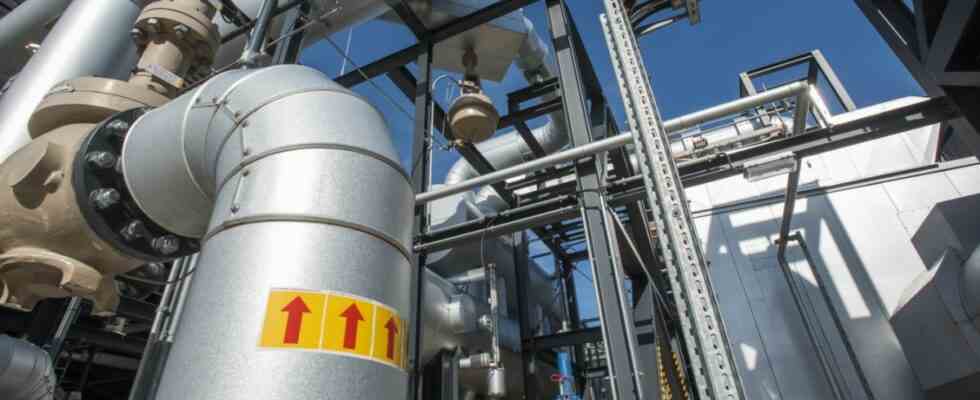In the case of new construction projects, the geothermal connection is now almost standard equipment in many communities in the district. In the past, on the other hand, homeowners were still hesitant about retrofitting if the old heating system would do for a few more years. But the increased prices of fossil fuels and now the war in Ukraine are increasing the desire to become independent of oil and gas supplies. This apparently leads to a faster rethinking: In Unterhaching, Pullach, Oberhaching and Unterföhring, the providers of deep heat confirm a sharp increase in demand for a connection to the district heating network. But that often doesn’t happen overnight.
If you take a look at the Unterhaching network plan, which shows the current progress of geothermal expansion, it becomes clear that the pipes have long since been laid in most of the streets. But the district heating in front of the door does not mean that it will also be in the house by next winter. Wolfgang Geisinger, the managing director of Geothermie Unterhaching, has to dampen expectations of a quick connection. “We have a lead time of one and a half to two years,” he says. The reason is delivery bottlenecks for the material and low capacity at the construction companies, “they are completely booked,” says Geisinger, and not every heating engineer can install district heating systems. The grant applications for this year have already been processed. Geisinger can hardly save himself from inquiries, there is currently twice as much demand as usual. But anyone who spontaneously decides to part with their oil or gas heating Geisinger currently has to put off until next year.
Wolfgang Geisinger, Managing Director of Geothermie Unterhaching.
(Photo: Claus Schunk)
Demand has also increased rapidly in Pullach. Helmut Mangold, Managing Director of Innovative Energie Pullach (IEP), speaks of an “incredible increase”. He received 20 inquiries on Monday and another ten on Tuesday morning. Otherwise, the IEP connects about 50 houses annually. 70 to 80 would do it. If the need grew even greater, the IEP would have to decide on the basis of urgency who would come first. There are around 2,700 buildings in the municipality, and almost 1,200 are already online. With the current capacity, the IEP could either connect all individual houses or the industry completely. “We need an additional well,” says Mangold.
Helmut Mangold, Managing Director Innovative Energie Pullach (IEP).
(Photo: Claus Schunk)
In Unterföhring they already exist. About 60 percent of the buildings are now connected to geothermal energy, in five to six years it should be up to 90 percent, according to the plan of Geovol Unterföhring GmbH. “In fact, we’ve had more inquiries since the beginning of the war,” says Managing Director Peter Lohr, “but we’re very well prepared.” With the new buildings in Unterföhring, demand has already increased, and so that there are no problems with delivery difficulties, Geovol started ordering material and keeping it available in warehouses last year due to the Corona crisis. There are also framework agreements with the construction companies, and two teams can be deployed quickly and flexibly. “We can complete a connection within a few weeks,” promises Lohr. The switch to geothermal energy is more dependent on whether there is still oil in the tank and whether the gas contract has already been terminated.
The municipal works in Oberhaching, which are pushing ahead with network expansion in the town, have recently had more construction companies on hand. Another working group (Arge) of a pipe and a civil engineering company was founded on the initiative of the municipal works specifically for this work. “This will make it possible for us, together with the consortium already active on site, to implement more than 100 house connections this year, maybe even up to 150, should material and delivery bottlenecks caused by the Ukraine war not make this more difficult,” says the managing director of Municipal works, Thomas Hummer. However, more than 150 connections per year cannot be managed in Oberhaching, especially since the construction sites are always accompanied by lane narrowing. Currently, Oberhaching has also reached an expansion of about 60 percent, and in five years they want to be at 85 percent, which would correspond to full development, “because it’s not possible everywhere,” says Hümmer, referring to remote buildings.
These men should accelerate the expansion of geothermal energy in Oberhaching: The new consortium.
(Photo: municipal works Oberhaching)
In Unterhaching, too, they want to speed up the expansion of geothermal energy. 1,500 of 4,000 objects have been developed, and there are already pipes in three quarters of the streets. “By the summer, we want to develop a strategy with the municipal council on how we can accelerate this,” says Managing Director Geisinger. But the good news is: “There is enough heat to heat the entire Munich area.”

